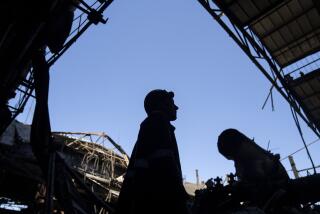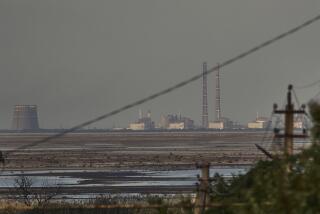Radioactivity Leaked by Russian Nuclear Plant : Reactor safety: Authorities say there is no health danger. But there are calls to cut use of atomic energy.
- Share via
MOSCOW — A Chernobyl-type reactor at St. Petersburg’s nuclear power plant sprang a leak Tuesday, and although safety devices switched on automatically, more radioactivity escaped into the air near Russia’s second-largest city than at Pennsylvania’s Three Mile Island in 1979, officials said.
Authorities assured Russians that the spurt of radiation from the Leningrad Nuclear Power Station’s No. 3 unit posed no danger to human health. But the incident, the most serious in nuclear power here since the 1986 Chernobyl accident in Ukraine, brought vigorous calls for an end to the economy’s virtual addiction to atomic energy.
“Russia cannot afford to develop nuclear power since the technology involved requires very strict observance of all regulations, which we simply cannot do at this stage,” said Alexei V. Yablokov, Russian state counselor for ecological affairs.
Around Europe, the incident sparked worry and short-lived fears that another accident the magnitude of Chernobyl might be in the making.
But this time, in pointed contrast to 1986, Moscow-based media such as the Russian Itar-Tass news agency and state-run television provided numerous, detailed reports and succeeded in averting panic.
Officials gave this account:
At 2:37 a.m., inside the power plant 40 miles west of St. Petersburg, a rupture developed in one of the 1,600 channels that normally supply water to the graphite-moderated, water-cooled, uranium-fueled reactor so it can be heated into steam.
As pressure surged dangerously inside the reactor, emergency systems kicked in automatically and brought the reactor, which can generate enough power to light up 10 million 100-watt bulbs, to “subcritical phase.”
But the break in the hermetic seal of the reactor, known as the RBMK-1000, sprayed radioactivity into the plant building that the ventilation system then carried into the outside air.
According to Russia’s State Committee for Emergencies, six times the permissible amounts of radioactive gases escaped and 10 times the radioactive iodine.
“This is a serious accident that causes insignificant consequences for the environment but serious pollution inside the reactor facilities,” said Yuri A. Rogozhin, spokesman for the State Committee on Nuclear Inspection.
Operating norms appeared to be strict enough that even exceeding them many times posed no hazard. Emissions at the time of the leak were the equivalent of 6,000 curies per day, but the head of Russian civil defense, Sergei Shoigu, said the total amount of radioactive particles thrown off was less than 2,000 curies, or what all four of the plant’s reactors would emit in 24 hours of normal operations.
Nevertheless, officials first announced that on the 7-point scale devised by the International Atomic Energy Agency, the leak rated a 3 as a “serious incident.” However, the Vienna-based agency later said in a statement that Russian authorities now rate the incident “at level 2” on the agency’s scales. “This would indicate that no significant levels of radiation exposure or contamination have occurred,” it said.
The April 26, 1986, Chernobyl explosion and fire in Ukraine, which killed 31 people outright and may have exposed 4 million others to potent doses of radiation, was a 7--a “global accident (catastrophe).”
Rogozhin said Tuesday’s incident was also on an “incomparably smaller scale” than the March 28, 1979, leak at Three Mile Island near Middletown, Pa., which he said rated a 6 on the IAEA scale. But, he noted, safety features at the Pennsylvania plant confined irradiated water and air inside the reactor building, while at the Leningrad Plant, although the leak was smaller, more radiation escaped.
“That only too vividly shows how safe the pressurized-water reactor (such as the Three Mile Island model) is, for it has a hermetic containment system, while Chernobyl-type reactors don’t,” said Rogozhin.
Specialists said the Leningrad Plant leak was likely to have been caused by equipment defects. At Three Mile Island, the effects of equipment failure were compounded by human error, and the resulting loss of coolant led to a partial meltdown of the reactor core.
By contrast, at Chernobyl, human error was the chief cause. While conducting tests, the staff had disabled safety systems but miscalculated temperatures within the reactor. An explosion occurred and the graphite used to moderate nuclear fission caught fire, spewing radioactive gases out into the atmosphere along with the smoke.
Yablokov, the Russian ecological official, said the Chernobyl-type RBMK reactors, of which 16 still function in the lands of the former Soviet Union, are “a source of high-danger risk” and should be shut down as soon as possible.
At the U.S. Consulate General in St. Petersburg, worried employees went on the roof to measure the radioactivity and found it was actually less than the previous day’s, Diana Moxhay, a consulate spokeswoman, reported. About 200 to 300 American students are in the northern Russian city, as well as 30 consular officials and their families.
Officials at the nuclear plant on the Gulf of Finland said none of the personnel were subjected to radiation. Sergei Galkin, deputy chief engineer in charge of reactor safety, said that in Sosnovy Bor, the plant’s bedroom community, no change in the usual background levels of radiation was detected.
Many European countries dusted by Chernobyl fallout nearly six years ago took precautionary measures. In Vienna, a hot line was opened to provide up-to-date information, and in Germany, a government commission began to monitor radioactivity in the air.
By Tuesday evening, such precautions seemed unnecessary.
“There is no (radioactive) cloud,” the director of the Leningrad plant, Anatoly P. Yeperin, assured the 5 million people of St. Petersburg and Russia’s neighbors as well.
Hans Bayard, director of emergency preparedness at the Swedish Institute of Radiation Protection, said his rough calculations showed that the emissions were “about 1 million times less than Chernobyl.”
Where the Leak Happened
A leak at a power station near St. Petersburg sprayed radiation that eventually was emitted outside the plant. Such reactors are a plumber’s nightmare of coils and tubing that carry water and steam between the core and power-generating turbines. Here is what happened:
1. The leak occurs in one of 1,600 vertical channels that carry water through the reactor.
2. Pressure surges dangerously inside the block.
Emergency systems are tripped and the reactor is brought to the “subcritical phase.”
But the break in the reactor, known as the RBMK-1000, sprays radioactive emissions into the plant building. The emissions are carried outside through the ventilation system. Russian officials later say filters rendered the radioactive gases and iodine harmless.
Russia’s State Committee for Emergencies says six times the permissible amounts of radioactive inert gases escaped and 10 times the radioactive iodine.
Source: National Geographic, NRC
More to Read
Sign up for Essential California
The most important California stories and recommendations in your inbox every morning.
You may occasionally receive promotional content from the Los Angeles Times.













